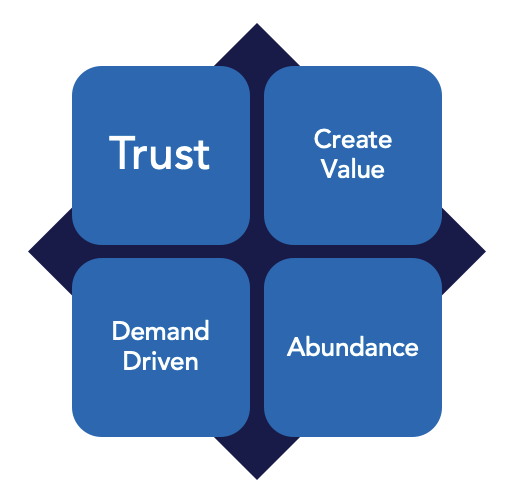Principles for an Adaptive Organization
How do we improve our customers' experience, productivity, and success while improving the efficiency and effectiveness of those who interact with our customers?
Members of the Consortium for Service Innovation have identified four principles that are the basis of the Consortium's work:
- Trust
- Create Value
- Demand Driven
- Abundance
As organizations strive to become more agile and adaptive, these four principles prove to be prerequisites for organizational transformation.

Overview of the Four Principles
The degree to which organizations embrace these four principles influences the level of success, realized benefits, and sustainability of each of the Consortium's methodologies.
If we want dramatically different results we have to do something dramatically different. There are no shortcuts.
Consortium for Service Innovation methodologies introduce a dramatically different way to think about and manage people, knowledge, and collaboration in an environment that is focused on organizational efficiency and customer success. The Consortium's methodologies are transformational and, depending on how well the organization embraces these four principles, create tremendous benefits for the organization, employees, and customers.
Implementing these methodologies creates an Adaptive Organization.
The goal of the Adaptive Organization is to quickly recognize and adjust to opportunities and changes in the environment
- Which leads to:
- engaged loyal customers, increased customer productivity and success
- engaged loyal employees, optimal use of employee skills, and rapid employee skills development
- Which in turn will:
- maximize profitability by creating relevant interactions and offerings as well as improving retention, referenceability, and growth.
The transformation to an Adaptive Organization starts with understanding the underlying organizational beliefs and moving away from beliefs that no longer serve us.
Beliefs Must Shift
Trust
A high degree of trust in employees leads to a high degree of employee engagement, which enables an excellent customer experience.
- Shift away from: Designing organizational structures, processes, and measures from the belief that employees add risk to decision making, and need to be told what to do.
- Embrace and encourage: Designing organizational structures, processes, and measures from the belief that employees are capable of good judgments and decisions, and that employees are the assets that create value.
Create Value
Understanding why promotes better decisions, enables creativity, and results in better outcomes. Value realization is about having a positive impact on those we serve, not about how we measure ourselves.
- Shift away from: A belief that employees only need to understand the tasks or activities they are assigned. A focus on assigning individual "credit" based solely on activities that can be counted.
- Embrace and encourage: A belief that employees will do better work when they understand the purpose, mission, values, and brand promise of the organization. A focus on what needs to be done in the context of why. A focus on outcomes and team performance.
Demand-Driven
In the face of ever-increasing change and complexity, a sense-and-respond model is more efficient and agile, and can be leveraged to improve the relevance of offerings.
- Shift away from: A linear, production line, command-and-control mentality. Relying on rigid, standardized processes to approach any problem, regardless of the nature of the situation.
- Embrace and encourage: An understanding that we are part of a system that we can influence, but cannot control. An appreciation for the dynamic networks in play, and using the appropriate approach based on the situation.
Abundance
Competition for things that could operate under a model of abundance severely stifles collaboration and creativity. Learning, growth, teamwork, and recognition thrive in an environment of abundance.
- Shift away from: Allowing the scarcity of time and money to dictate a scarcity model in all situations.
- Embrace and encourage: Recognizing when an abundance model is more appropriate and effective (in situations such as knowledge, relationships, and reputation).
While these four principles are interconnected and support each other, trust is the keystone. If trust is not present in the environment, the benefit of embracing the other three principles is greatly diminished.
Detailed Descriptions of the Four Principles
Principles For An Adaptive Organization by Consortium for Service Innovation is licensed under a Creative Commons Attribution-NonCommercial-NoDerivatives 4.0 International License.

